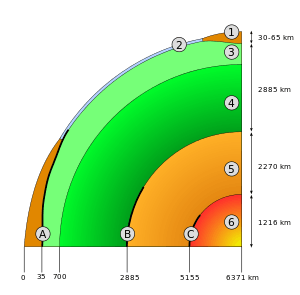Core–mantle boundary

1. continental crust
2. oceanic crust
3. upper mantle
4. lower mantle
5. outer core
6. inner core
A: Mohorovičić discontinuity
B: core–mantle boundary (Gutenberg discontinuity)
C: outer core–inner core boundary
The core–mantle boundary (CMB in the parlance of solid earth geophysicists) of the Earth lies between the planet's silicate mantle and its liquid iron-nickel outer core. This boundary is located at approximately 2891 km (1796 mi) depth beneath the Earth's surface. The boundary is observed via the discontinuity in seismic wave velocities at that depth. This discontinuity is due to the differences between the acoustic impedances of the solid mantle and the molten outer core. P-wave velocities are much slower in the outer core than in the deep mantle while S-waves do not exist at all in the liquid portion of the core. Recent evidence suggests a distinct boundary layer directly above the CMB possibly made of a novel phase of the basic perovskite mineralogy of the deep mantle named post-perovskite. Seismic tomography studies have shown significant irregularities within the boundary zone and appear to be dominated by the African and Pacific large low-shear-velocity provincess (LLSVP).[1]
The ~200 km thick layer of the lower mantle directly above the boundary is referred to as the D″ ("D double-prime" or "D prime prime") and is sometimes included in discussions regarding the core–mantle boundary zone.[2] The D″ name originates from the mathematician Keith Bullen's designations for the Earth's layers. His system was to label each layer alphabetically, A through G, with the crust as 'A' and the inner core as 'G'. In his 1942 publication of his model, the entire lower mantle was the D layer. In 1950, Bullen found his 'D' layer to actually be two different layers. The upper part of the D layer, about 1800 km thick, was renamed D′ (D prime) and the lower part (the bottom 200 km) was named D″.
The bottom of D″ has been observed in some regions to be marked by a seismic velocity discontinuity (sometimes known as the 'Gutenberg discontinuity', after German geophysicist Beno Gutenberg) .[3]
Slow small-scaled structures have been discovered on the core-mantle boundary, these are dubbed ultra-low velocity zones (ULVZs).
See also
Notes
- ↑ Lekic, V.; Cottaar, S.; Dziewonski, A. & Romanowicz, B. (2012). "Cluster analysis of global lower mantle". Precambrian Research. 127 (1–3): 167–180. doi:10.1016/S0301-9268(03)00186-4.
- ↑ WR Peltier (2007). "Mantle Dynamics and the D" Layer: Impacts of the Post Perovskite Phase". In Kei Hirose; John Brodholt; Thome Lay; David Yuen. Post-Perovskite: The Last Mantle Phase Transition (PDF). Volume 174 in AGU Geophysical Monographs. American Geophysical Union. pp. 217–227. ISBN 978-0-87590-439-9.
- ↑ Audrey Slesinger (January 2001), "Earth's interior: Redefining the Core–Mantle Boundary", Geotimes, The American Geological Institute, retrieved 2011-03-24
External links
- Earth's Core–Mantle Boundary Has Core-Rigidity Zone
- Audrey Slesinger (January 2001), "Earth's interior: Redefining the Core–Mantle Boundary", Geotimes, The American Geological Institute, retrieved 2011-03-24
- Mineral phase change at the boundary
- Superplumes at the boundary
- About.com article on the name of D″